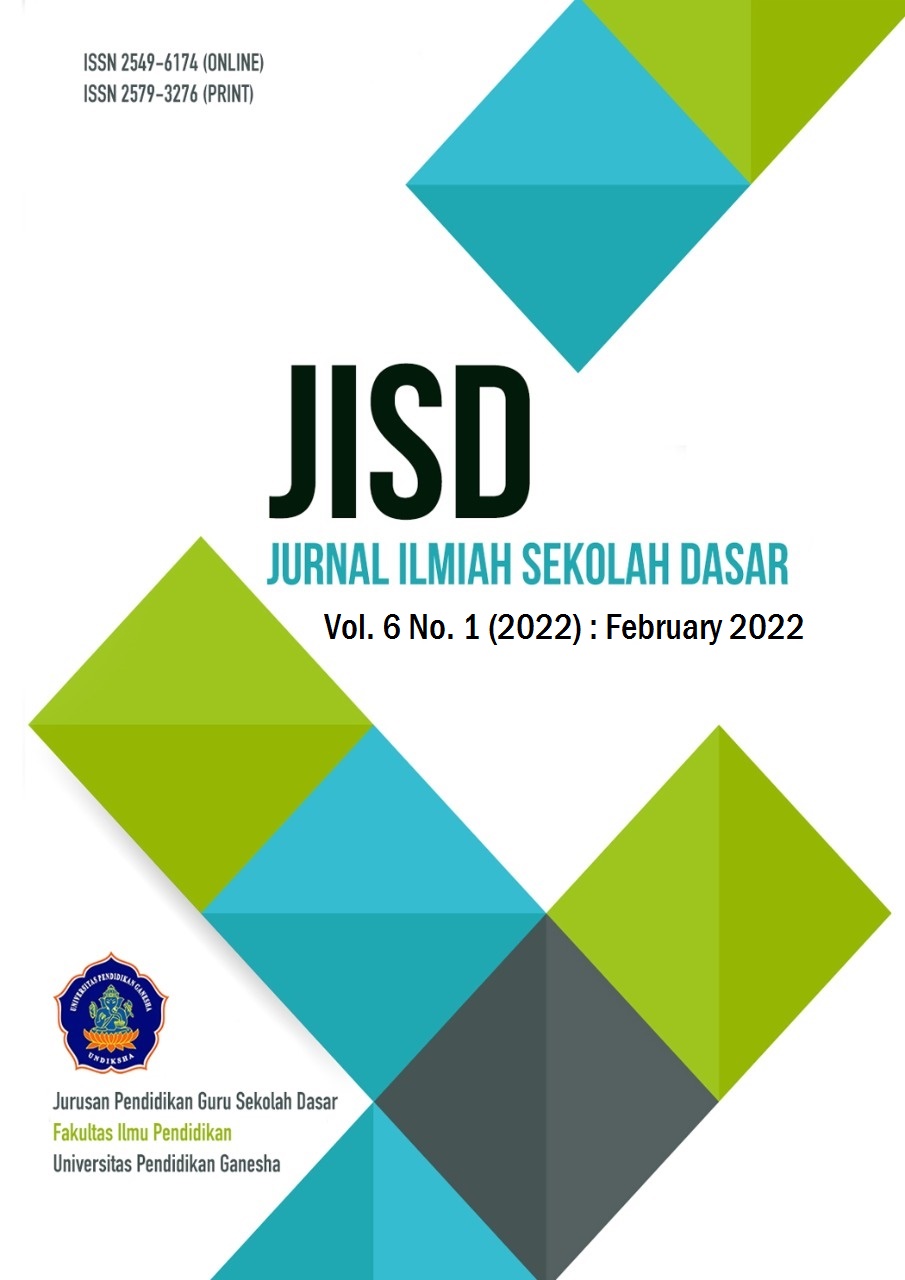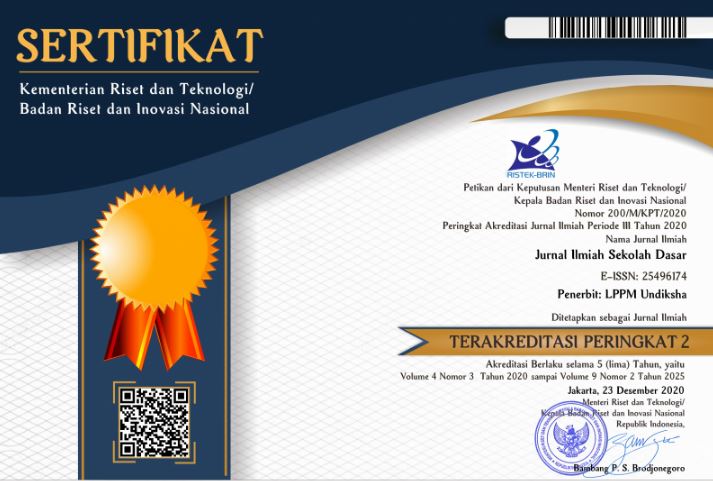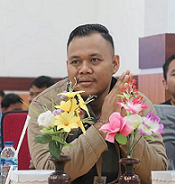Reversible Thinking of Fifth Graders: Focus on Linier Equations
DOI:
https://doi.org/10.23887/jisd.v6i1.44017Keywords:
Reversible Thinking, Linear Equations, Elementary SchoolAbstract
Reversible thinking is the mental ability to return the way of thinking to the original point. This study explores the reversible thinking of fifth graders on linear equations. This descriptive-exploratory research was conducted on 96 fifth-grade elementary school students. Data collection is done by providing reversible thinking and interviews. The technique used for data analysis is qualitative and quantitative description analysis. The assignment contains a linear equation (called the initial equation). Students are asked to make an equation equivalent to the initial equation. All equations that students successfully created were then analyzed and classified based on the strategies used. Next, one student with the most diverse approach was selected to be explored more deeply in reversible thinking. The results of the study, there are ten categories of students' reversible thinking strategies, among others, first, moving the elements of the initial equation builder. Second, determine the unknown factors. Third, operate both sides of the initial equation with the same number. Fourth, operate both as equations of equivalent expressions. Fifth, change the known building elements in the created equation. Sixth refers to the value of the unknown component then converts that value into a presentation. Seventh, transforming the building elements that are known in the initial equation. Eighth refers to the value of the initial equation variable. Ninth, using the definition of subtraction. Tenth, using the commutative property of the operation of the number.
References
Ábrahám, E., Davenport, J. H., England, M., & Kremer, G. (2021). Deciding the consistency of non-linear real arithmetic constraints with a conflict driven search using cylindrical algebraic coverings. Journal of Logical and Algebraic Methods in Programming, 119. https://doi.org/10.1016/j.jlamp.2020.100633. DOI: https://doi.org/10.1016/j.jlamp.2020.100633
Arnau, D., Arevalillo-Herráez, M., Puig, L., & González-Calero, J. A. (2013). Fundamentals of the design and the operation of an intelligent tutoring system for the learning of the arithmetical and algebraic way of solving word problems. Computers & Education, 63. https://doi.org/10.1016/j.compedu.2012.11.020. DOI: https://doi.org/10.1016/j.compedu.2012.11.020
Billstein, R., Libeskind, S., & Lott, J. W. (1990). A Problem Solving Approach to Mathematics for Elementary School Teachers (Fourth Edi). California: The Banjamin/Cummings Publishing Company.
Buium, A., & Miller, L. E. (2020). Solutions to arithmetic differential equations in algebraically closed fields. Advances in Mathematics, 375. https://doi.org/10.1016/j.aim.2020.107342. DOI: https://doi.org/10.1016/j.aim.2020.107342
Daulay, L. A., Hakim, H., & Sartikawati, L. D. (2019). The Improvement Of Student’s Mathematical Communication Ability By Using Cooperative Learning: Course Review Horay. Tarbiyah, 26(1). https://doi.org/10.30829/tar.v26i1.376. DOI: https://doi.org/10.30829/tar.v26i1.376
Eze, S. C., Chinedu-Eze, V. C., & Bello, A. O. (2018). The utilisation of e-learning facilities in the educational delivery system of Nigeria: a study of M-University. International Journal of Educational Technology in Higher Education, 15(1). https://doi.org/10.1186/s41239-018-0116-z. DOI: https://doi.org/10.1186/s41239-018-0116-z
Fadillah, & Jamilah. (2016). Pengembangan Bahan Ajar Struktur Aljabar Untuk Meningkatkan Kemampuan Pembuktian Matematis Mahasiswasyarifah. Cakrawala Pendidikan, 35(1), 106–108. https://doi.org/10.21831/cp.v1i1.8379. DOI: https://doi.org/10.21831/cp.v1i1.8379
Fitmawati, E. E., Siswono, T. Y. E., & Lukito, A. (2019). Student’s Reversibility in Solving Algebraic Problem. International Journal of Trends in Mathematics Education Research, 2(4). https://doi.org/10.33122/ijtmer.v2i4.98. DOI: https://doi.org/10.33122/ijtmer.v2i4.98
Greenes, C. (2004). Algebra : It ’ s Elementary.
Hackenberg, A. J. (2010). Students’ reasoning with reversible multiplicative relationships. Cognition and Instruction, 28(4), 383–432. https://doi.org/10.1080/07370008.2010.511565.
Hafner, R. J., White, M. P., & Handley, S. J. (2012). Spoilt for choice: The role of counterfactual thinking in the excess choice and reversibility paradoxes. Journal of Experimental Social Psychology, 48(1). https://doi.org/10.1016/j.jesp.2011.06.022. DOI: https://doi.org/10.1016/j.jesp.2011.06.022
Hendriana, H., Johanto, T., & Sumarmo, U. (2018). The role of problem-based learning to improve students’ mathematical problem-solving ability and self confidence. Journal on Mathematics Education, 9(2), 291–299. https://doi.org/10.22342/jme.9.2.5394.291-300. DOI: https://doi.org/10.22342/jme.9.2.5394.291-300
Humberstone, J., & Reeve, R. A. (2018). The conceptual overlap between arithmetic and algebraic referential mapping. Learning and Instruction, 54. https://doi.org/10.1016/j.learninstruc.2017.09.001. DOI: https://doi.org/10.1016/j.learninstruc.2017.09.001
Ikram, M., Purwanto, Parta, I. N., & Susanto, H. (2020). Exploring the potential role of reversible reasoning: Cognitive research on inverse function problems in mathematics. Journal for the Education of Gifted Young Scientists, 8(1), 591–611. https://doi.org/10.17478/jegys.665836. DOI: https://doi.org/10.17478/jegys.665836
Inhelder, B., & Piaget, J. (1958). The growth of logical thinking from childhood to adolescence. New York: Basic Books. DOI: https://doi.org/10.1037/10034-000
Krutetskii, V. A. (1976). The psychology of mathematical abilities in schoolchildren. Chicago: The University of Chicago Press.
Lindvig, K., & Mathiasen, H. (2020). Translating the Learning Factory model to a Danish Vocational Education Setting. Translating the Learning Factory Model to a Danish Vocational Education Setting, 45. https://doi.org/10.1016/j.promfg.2020.04.077. DOI: https://doi.org/10.1016/j.promfg.2020.04.077
Maf’Ulah, S., Fitriyani, H., Yudianto, E., Fiantika, F. R., & Hariastuti, R. M. (2019). Identifying the reversible thinking skill of students in solving function problems. Journal of Physics: Conference Series, 1188(1). https://doi.org/10.1088/1742-6596/1188/1/012033. DOI: https://doi.org/10.1088/1742-6596/1188/1/012033
Maf’ulah, S., & Juniati, D. (2019). Students’ Strategies to Solve Reversible Problems of Function: The Part of Reversible Thinking. Journal of Physics: Conference Series, 1417(1). https://doi.org/10.1088/1742-6596/1417/1/012051. DOI: https://doi.org/10.1088/1742-6596/1417/1/012051
Maf’ulah, S., & Juniati, D. (2020). Exploring reversible thinking of preservice mathematics teacher students through problem-solving task in algebra. Journal of Physics: Conference Series, 1663(1). https://doi.org/10.1088/1742-6596/1663/1/012003. DOI: https://doi.org/10.1088/1742-6596/1663/1/012003
Maf’ulah, S., Juniati, D., & Siswono, T. Y. E. (2017). The aspects of reversible thinking in solving algebraic problems by an elementary student winning national Olympiad medals in science. World Transactions on Engineering and Technology Education.
Maf’ulah, Syarifatul, & Juniati, D. (2020). The effect of learning with reversible problem-solving approach on prospective-math-teacher students’ reversible thinking. International Journal of Instruction, 13(2), 329–342. https://doi.org/10.29333/iji.2020.13223a. DOI: https://doi.org/10.29333/iji.2020.13223a
Maf’ulah, Syarifatul, & Juniati, D. (2021). Prospective Mathematics- Teacher Students ’ Reversible Thinking in Solving Math Insurance Problem. Turkish Journal of Computer and Mathematics Education, 12(6), 3124–3131.
McMullen, J., Brezovszky, B., Hannula-Sormunen, M. M., Veermans, K., Rodríguez-Aflecht, G., Pongsakdi, N., & Lehtinen, E. (2017). Adaptive number knowledge and its relation to arithmetic and pre-algebra knowledge. Learning and Instruction, 49. https://doi.org/10.1016/j.learninstruc.2017.02.001. DOI: https://doi.org/10.1016/j.learninstruc.2017.02.001
Muzaini, M., Ikram, M., & Sirajuddin, S. (2021). Analisis Proses Terjadinya Penalaran Reversibel Untuk Masalah Invers. Jurnal Aksioma, 10(2). https://doi.org/10.24127/ajpm.v10i2.3450. DOI: https://doi.org/10.24127/ajpm.v10i2.3450
NCTM. (2000). Principles and Standards for School Mathematics. National Council of Teachers of Mathematics.
Polya, G. (1973). How to solve it. Princeton, NJ: Princeton University Press. https://doi.org/10.1080/07370008.2010.511565. DOI: https://doi.org/10.1080/07370008.2010.511565
Powell, S. R. (2012). Equations and the equal sign in elementary mathematics textbooks. The Elementary School Journal, 112(4), 627–648. https://doi.org/https://doi.org/10.1086/665009. DOI: https://doi.org/10.1086/665009
Ramful, A. (2009). Reversible Reasoning In Multiplicative Situations: Conceptual Analysis, Affordances and Constralints. Unpub. Doct. Dissertation.
Ramful, Ajay. (2015). Reversible reasoning and the working backwards problem solving strategy. Australian Mathematics Teacher, 71(4), 28–32.
Ranti, M. G., Budiarti, I., & Trisna, B. N. (2017). Pengaruh Kemandirian Belajar (Self Regulated Learning) Terhadap Hasil Belajar Mahasiswa Pada Mata Kuliah Struktur Aljabar. Math Didactic, 3(1), 75–83. https://doi.org/10.33654/math.v3i1.57. DOI: https://doi.org/10.33654/math.v3i1.57
Saparwadi, L., Sa’dijah, C., As’ari, A. R., & Chandrad, T. D. (2020). The aspects and stages of reversible thinking of secondary school students in resolving the problems of fractional numbers. Systematic Reviews in Pharmacy, 11(6), 1302–1310. https://doi.org/10.31838/srp.2020.6.190.
Sari, A. N., Wahyuni, R., & Rosmaiyadi, R. (2016). Penerapan Pendekatan Open-Ended untuk Meningkatkan Kemampuan Berpikir Kritis Siswa Pada Materi Aljabar Kelas VIII SMP Negeri 10 Pemangkat. JPMI (Jurnal Pendidikan Matematika Indonesia), 1(1), 20. https://doi.org/10.26737/jpmi.v1i1.78. DOI: https://doi.org/10.26737/jpmi.v1i1.78
Setiyani, S., Fitriyani, N., & Sagita, L. (2020). Improving student’s mathematical problem solving skills through Quizizz. JRAMathEdu (Journal of Research and Advances in Mathematics Education), 5(3), 276–288. https://doi.org/10.23917/jramathedu.v5i3.10696. DOI: https://doi.org/10.23917/jramathedu.v5i3.10696
Sharma, L., & Srivastava, M. (2020). Teachers’ motivation to adopt technology in higher education. Journal of Applied Research in Higher Education, 12(4), 673–692. https://doi.org/10.1108/JARHE-07-2018-0156. DOI: https://doi.org/10.1108/JARHE-07-2018-0156
Silwana, A., Subanji, S., Manyunu, M., & Rashahan, A. A. (2020). Students’ Responses Leveling in Solving Mathematical Problem Based on SOLO Taxonomy Viewed from Multiple Intelligences. Indonesian Journal on Learning and Advanced Education (IJOLAE), 3(1), 1–16. https://doi.org/10.23917/ijolae.v3i1.10528. DOI: https://doi.org/10.23917/ijolae.v3i1.10528
Sumirattana, S., Siriporn, M., & Thipkongc, A. (2017). Using realistic mathematics education and the DAPIC problem-solving process to enhance secondary school students’ mathematical literacy. Kasetsart Journal of Social Sciences, 8(3). https://doi.org/10.1016/j.kjss.2016.06.001. DOI: https://doi.org/10.1016/j.kjss.2016.06.001
Surya, E., Putri, F. A., & Mukhtar. (2017). Improving Mathematical Problem-solving Ability and Self-confidence of High School Students Through Contextual Learning Model. Journal on Mathematics Education, 8(1), 85–94. https://doi.org/10.22342/jme.8.1.3324.85-94. DOI: https://doi.org/10.22342/jme.8.1.3324.85-94
Sutiarso, S. (2020). Analysis of Student Reversible Thinking Skills on Graph Concept. Indonesian Journal of Science and Mathematics Education, 3(2). https://doi.org/10.24042/ijsme.v3i2.6768. DOI: https://doi.org/10.24042/ijsme.v3i2.6768
Zandieh, M., & Rasmussen, C. (2010). Defining as a mathematical activity: A framework for characterizing progress from informal to more formal ways of reasoning. The Journal of Mathematical Behavior, 29(2). https://doi.org/10.1016/j.jmathb.2010.01.001. DOI: https://doi.org/10.1016/j.jmathb.2010.01.001
Downloads
Published
How to Cite
Issue
Section
License
Copyright (c) 2022 Syarifatul Maf'ulah

This work is licensed under a Creative Commons Attribution-ShareAlike 4.0 International License.
Authors who publish with the Journal Ilmiah Sekolah Dasar agree to the following terms:
- Authors retain copyright and grant the journal the right of first publication with the work simultaneously licensed under a Creative Commons Attribution License (CC BY-SA 4.0) that allows others to share the work with an acknowledgment of the work's authorship and initial publication in this journal.
- Authors are able to enter into separate, additional contractual arrangements for the non-exclusive distribution of the journal's published version of the work (e.g., post it to an institutional repository or publish it in a book), with an acknowledgment of its initial publication in this journal.
- Authors are permitted and encouraged to post their work online (e.g., in institutional repositories or on their website) prior to and during the submission process, as it can lead to productive exchanges, as well as earlier and greater citation of published work. (See The Effect of Open Access)










